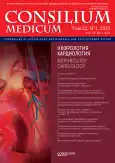Hyperuricemia as a risk factor of contrast-induced acute kidney injury
- Authors: Mironova O.l.1, Lakotka P.G.1, Fomin V.V.1
-
Affiliations:
- Sechenov First Moscow State Medical University (Sechenov University)
- Issue: Vol 23, No 1 (2021)
- Pages: 25-27
- Section: Articles
- URL: https://journals.rcsi.science/2075-1753/article/view/95387
- DOI: https://doi.org/10.26442/20751753.2021.1.200572
- ID: 95387
Cite item
Full Text
Abstract
Full Text
##article.viewOnOriginalSite##About the authors
Olga lu. Mironova
Sechenov First Moscow State Medical University (Sechenov University)
Email: mironova_o_yu@staff.sechenov.ru
канд. мед. наук, доц. каф. факультетской терапии Moscow, Russia
Polina G. Lakotka
Sechenov First Moscow State Medical University (Sechenov University)аспирант каф. факультетской терапии Moscow, Russia
Viktor V. Fomin
Sechenov First Moscow State Medical University (Sechenov University)чл.-кор. РАН, д-р мед. наук, проф., проректор по клинической работе и дополнительному профессиональному образованию, зав. каф. факультетской терапии Moscow, Russia
References
- Cheungpasitporn W, Thongprayoon C, Harrison AM, Erickson SB. Admission hyperuricemia increases the risk of acute kidney injury in hospitalized patients. Clin Kidney J 2016; 9 (1): 51-6.
- Kang MW, Chin HJ, Joo KW, et al. Hyperuricemia is associated with acute kidney injury and allcause mortality in hospitalized patients. Nephrology 2019; 24 (7): 718-24.
- Xu X, Hu J, Song N, et al. Hyperuricemia increases the risk of acute kidney injury: A systematic review and meta-analysis. BMC Nephrol 2017; 18 (1): 1-14. doi: 10.1186/s12882-016-0433-1
- Richette P, Doherty M, Pascual E, et al. 2016 updated EULAR evidence-based recommendations for the management of gout. Ann Rheum Dis 2017; 76 (1): 29-42.
- Keeley EC, Boura JA, Grines CL. Primary angioplasty versus intravenous thrombolytic therapy for acute myocardial infarction: A quantitative review of 23 randomised trials. Lancet 2003; 361 (9351): 13-20.
- Guo W, Song F, Chen S, et al. The relationship between hyperuricemia and contrast-induced acute kidney injury undergoing primary percutaneous coronary intervention: Secondary analysis protocol for the ATTEMPT RESCIND-1 study. Trials 2020; 21 (1): 1-5.
- KDIGO Working Group. Clinical Practice Guideline for Acute Kidney Injury. Kidney Int Suppl 2012;(1): 124-38. Available at: http://www.kdigo.org/clinical_practice_guidelines/pdf/KDIGO AKI Gui-deline.pdf
- Williams B, Mancia G, De Backer G, et al. 2018 Guidelines for the Management of Arterial Hypertension: The Task Force for the Management of Arterial Hypertension of the European Society of Hypertension (ESH) and of the European Society of Cardiology (ESC). J Hypertens 2018; 25 (6): 1105-87.
- Ponikowski P, Voors AA, Anker SD, et al. 2016 ESC Guidelines for the diagnosis and treatment of acute and chronic heart failure. Eur Heart J 2016; 37 (27): 2129-200m.
- Dedov II, Shestakova MV, Mayorov AY, et al. Standards of specialized diabetes care. Diabetes Mellit 2017; 20 (1S): 1-112.
- Khanna D, Fitzegarld J, Khanna P, et al. 2012 American College of Rheumatology Guidelines for Management of Gout Part I: Systematic Non-pharmacologic and Pharmacologic Therapeutic Approaches to Hyperuricemia. Arthritis Care Res 2012; 64 (10): 1431-46. Available at: http://www.ncbi.nlm.nih.gov/pubmed/3683400%5Cnhttp://www.pubmedcentral.nih.gov/articlerender.f cgi?artid=PMC368044
- Алиментарные анемии. Доклад научной группы ВОЗ. Женева, 1970
- Mehran R, Aymong ED, Nikolsky E, et al. A simple risk score for prediction of contrast-induced nephropathy after percutaneous coronary intervention: Development and initial validation. J Am Coll Cardiol 2004; 44 (7): 1393-9. doi: 10.1016/j.jacc.2004.06.068
Supplementary files






